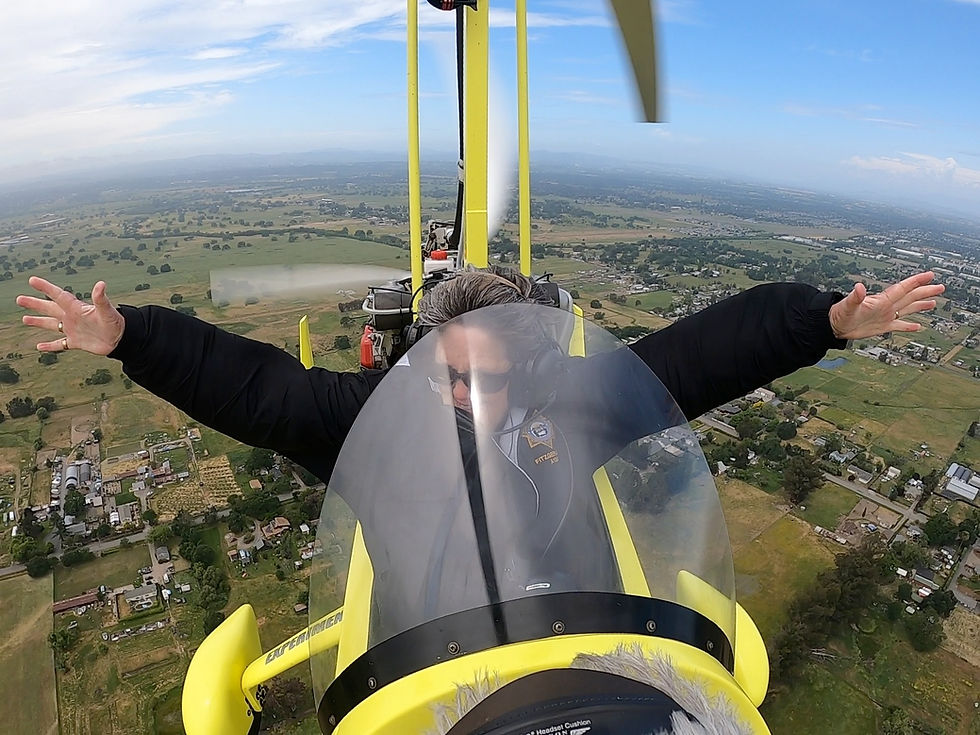#1: What the heck is a Gyroplane?
- Paul Hollingworth

- Sep 3
- 3 min read
Updated: Sep 11
A gyroplane looks like this.

At first glance it may look like a helicopter but actually it works and flies more like a normal plane. Although there's a rotor which provides lift, the rotor is not powered by the engine, but just by the wind passing up through it. (Pause for you to process that and go, “Wait, what…?”) No, that’s right. The rotor is not powered by the engine.
The engine turns the propellor at the back, which pushes the gyroplane forward. The rotating wing (which is what a rotor actually is), is angled backwards in flight and so the air rushes up through it. This causes it to turn and that generates the lift that keeps it in the sky. They were developed in the early days of aviation as a way to make an aircraft that could never stall and where if the engine failed, you would just glide down and land in a small space. As a result, modern gyros are very safe.
Gyroplanes come in different shapes and types, but all share this characteristic way of flying. Aside from the inherent safety of the rotor always rotating, there are other things that make gyros safer than other forms of flying.
Firstly, any forward momentum can be easily converted into lift – this means that as you get down to the ground, you bleed off the airspeed and settle down in a very short distance. You can therefore land in a much smaller space than an airplane. Secondly, the blade area is very small versus a normal pair of wings. This is very good in turbulence and means we can fly gyros on days when other light aircraft are grounded by the weather.
Lastly, you can’t stall a gyroplane. This is a big deal because a large fraction of accidents that have killed pilots and their passengers have to do with stalls. A stall happens when a wing stops flying, because the smooth flow of air over the wing gets disrupted. This is usually because the pilot is exceeding the angle of attack for the speed of flight, either through attempting to climb too steeply or, more often, trying to turn too fast and steeply. Gyros can’t stall because the wing is always rotating and the air is always moving up through it. This mean that we can turn with astonishing speed and in a very small raduis – great for getting out of spaces that turned out to be tighter than expected.
Although gyros date originally from the 1930s, after a brief period they never took off (sorry) commercially. Why? Because airplanes got safer as people got better at designing and flying them, and the additional speed and load capacity they provided was what commerce really wanted. Then the helicopter evolved out of the gyro when Igor Sikorsky came up with the idea of driving the rotor from the engine. And helicopters do have a couple of magic tricks that gyros don’t – they can hover, and they can take off and land vertically. But they are much more mechanically complex and maintenance-heavy, much harder to fly and much more expensive to buy and run per hour.
So a gyroplane isn’t exactly a plane, and it certainly isn’t a helicopter. Why do I claim that gyroplanes offer the joy of the sky better than other forms of flying? It’s partly personal experience over many flying hours – it never gets old. It’s partly having flown most other types of aircraft and being able to compare directly. (Any time I can go flying and be in the sky is probably going to be a good day, but in the gyro it’s pretty much guaranteed!)
But perhaps most importantly, it’s reinforced by the opinions of the many people I’ve taken flying in the gyro, especially the other pilots, as they have the most relevant experience with which to compare it. Have a look at the Testimonials page https://www.bayareagyro.com/testimonials for real verbatim comments from some of my passengers and see what they had to say about it.
Gyros are unique and the most fun to fly of anything that you can find in the sky. If you don’t believe me, come and have a go and I’ll prove it to you.




Comments